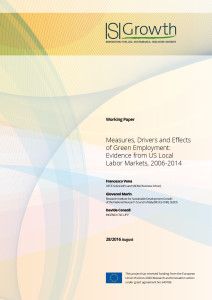This paper explores the nature and the key empirical regularities of green employment in US local labor markets between 2006 and 2014. We construct a new measure of green employment based on the task content of occupations. Descriptive analysis reveals the following: 1. the share of green employment oscillates between 2 and 3 percent, and its trend is strongly pro-cyclical; 2. green jobs yield a 4 percent wage premium; 3. despite moderate catching-up across areas, green jobs remain more geo-graphically concentrated than similar non-green jobs; and 4. the top green areas are mostly high-tech. As regards the drivers, changes in environmental regulation are a secondary force compared to the local endowment
of green knowledge and resilience in the face of the great recession. To assess the impact of moving to greener activities, we estimate that one additional green job is associated with 4.2 (2.2 in the crisis period) new jobs in non-tradable activities in the local economies.
Measures, Drivers and Effects of Green Employment: Evidence from US Local Labor Markets, 2006-2014
Francesco Vona
OFCE-SciencesPo and SKEMA Business School
Giovanni Marin
Research Institute for Sustainable Development Growth of the National Research
Council of Italy (IRCrES-CNR), SEEDS
Davide Consoli
INGENIO CSIC-UPV
Working Paper
28/2016 August

